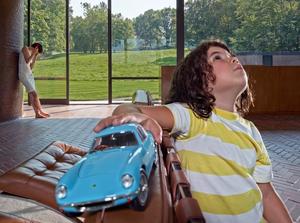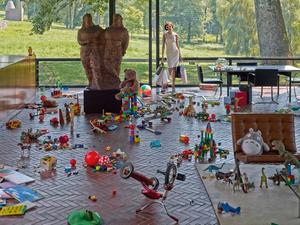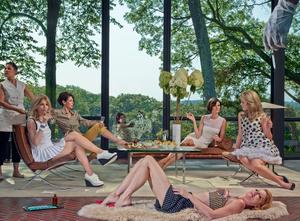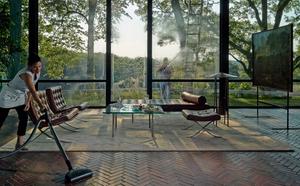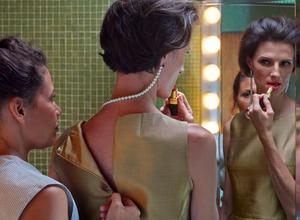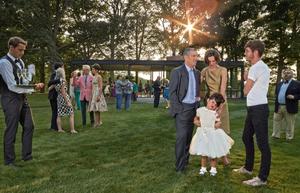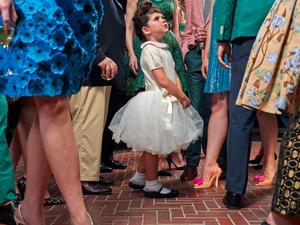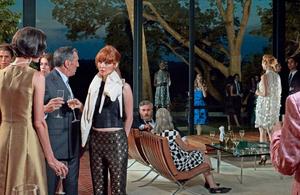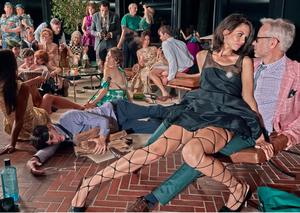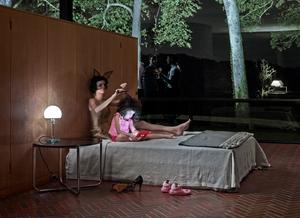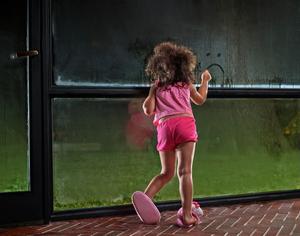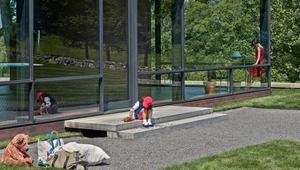
THELOOK
The Look is a photo essay about architecture and fashion. It is structured as a narrative in eighteen scenes that reflect on youth, aging, timelessness, and identity. It is set in Philip Johnson’s Glass House in an ambiguous time. A curated selection of ten fashion accessories, which comprise a 2013 capsule collection commissioned by the DESTE Foundation, are dispersed throughout. Ranging from runway couture to ready-to-wear collections, the pieces are “assisted” classics: they are so aligned with today’s sensibilities that they live in the state of the past-present. The articles of the capsule collection, in order of appearance, are: cork shoes by Martin Margiela (A); Yuwano sunglasses by Lotho (B); Converse wedges by Rock & Candy (C); a pearl necklace-earring by Slow and Steady Wins the Race (D); Drip sneakers by Martin Margiela (E); a faux-fox stole by Slow and Steady Wins the Race (F); a Blu brand e-cigarette (G); Lady Dragon flesh-colored pumps by Vivienne Westwood for Melissa (H); jumbo fishnet stockings by Leg Avenue (I); and a bunny-ear veil by Maison Michel (J).
Architecture is to buildings as fashion is to clothing: both may be seen as excesses of their functional roots. Whereas in fashion the adjective “architectural” is an asset—a positive term that applies to a design with distinctively strong structure and form—the term “fashionable” is pejorative in architecture, suggesting a fleeting trend with no enduring qualities. Architecture’s aspiration to permanence is a product not only of the significant investment required to build but also of its commitment to lasting value. Fashion, by contrast, is driven by the manic desire to refresh. The life span of a trend is a season, not a century. But both disciplines converge at the “classic,” a status reserved for rare designs of irreducible perfection that withstand the test of time.
One of architecture’s Modernist icons, Philip Johnson’s Glass House of 1949, provides the setting for the narrative. An influential Museum of Modern Art board member and first director of the museum’s architecture department, Johnson used the house as a salon, hosting New York’s cultural elite in gatherings that were documented in candid photographs taken over more than forty years. Each decade, from the 1950s through the 1990s, is well represented: the time period of each photograph is discernible in the guests’ varying clothing styles set against the classic, unchanging backdrop of the house. These archival photographs are a record of the past half century of fashion.
Occasionally, the images reveal unexpected alignments between architecture and fashion. The preppy-hipster look of Andy Warhol visiting the Glass House in 1964 could easily be mistaken for that of a fashion-forward visitor today. A garden-party guest wearing a Christian Dior Bar suit in 1947 might appear similar to a present-day visitor dressed in one of Dior’s New Look revivals designed by Raf Simons. As trends come and go—only to return again—the fast wheel of fashion sometimes aligns with the slow motion of architecture. This peculiar synchrony between “fashion time” and “architecture time” is both unsettling and liberating.
The Look was photographed by Matthew Monteith and commissioned by the DESTE Foundation.
| Location Benaki Museum, New Canaan, United States |
| Team | Elizabeth Diller,Ricardo Scofidio,Kumar Atre,Edgar Forrest Jessee,Trevor Lamphier,and Jaffer Kolb |
| Matthew Monteith | Photographer |
| DESTE Foundation | Commissioner |



